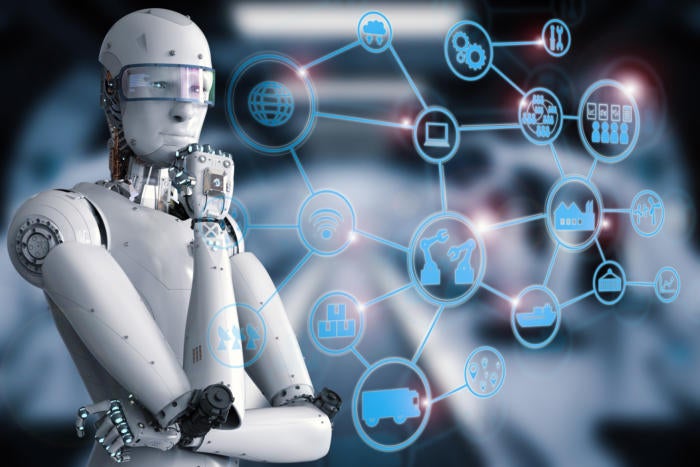The basic principle of robotics and AI
Artificial intelligence applied to robotics development requires a different set of skills from you, the robot designer or developer. You may have made robots before. You probably have a quadcopter or a 3D printer. The familiar world of Proportional Integral Derivative (PID) controllers, sensor loops, and state machines must give way to artificial neural networks, expert systems, genetic algorithms, and searching path planners. We want a robot that does not just react to its environment as a reflex action, but has goals and intent—and can learn and adapt to the environment. We want to solve problems that would be intractable or impossible otherwise.
Robotics or a robotics approach to AI—that is, is the focused learning about robotics or learning about AI? about how to apply AI tools to robotics problems, and thus is primarily an AI using robotics as an example. The tools and techniques learned will have applicability even if you don’t do robotics, but just apply AI to decision making to trade on the stock market.
What we are going to do is first provide some tools and background to match the infrastructure that was used to develop. This is both to provide an even playing field and do not assume any knowledge on the reader’s part. We will use the Python programming language, the ROS for our data infrastructure, and be running under the Linux operating system. Oracle’s VirtualBox software running Ubuntu Linux in a virtual machine on a Windows Vista computer. Our robot hardware will be a Raspberry Pi 3 as the robot’s on-board brain, and an Arduino Mega2560 as the hardware interface microcontroller.
In the rest of this chapter, we will discuss some basics about AI, and then proceed to develop two important tools. We will introduce the concept of soft real-time control, and then provide a framework, or model, for interfacing AI to our robot called the Observe-Orient-Decide-Act (OODA) loop.
What is AI (and what is it not)?
What would be a definition of AI? In general, it means a machine that exhibits some characteristics of intelligence—thinking, reasoning, planning, learning, and adapting. It can also mean a software program that can simulate thinking or reasoning. Let’s try some examples: a robot that avoids obstacles by simple rules is not an AI. A program that learns by example to recognize a cat in a video, is an AI. A mechanical arm that is operated by a joystick is not AI, but a robot arm that adapts to different objects to pick them up is AI.
There are two defining characteristics of artificial intelligence robots that you must be aware of. First of all, AI robots learn and adapt to their environments, which means that they change behaviors over time. The second characteristic is emergent behavior, where the robot exhibits developing actions that we did not program into it explicitly. We are giving the robot controlling software that is inherently non-linear and self-organizing.
The robot may suddenly exhibit some bizarre or unusual reaction to an event or situation that seems to be odd, or quirky, or even emotional. I worked with a self-driving car that we swore had delicate sensibilities and moved very daintily, earning it the nickname Ferdinand after the sensitive, flower-loving bull from the cartoon, which was appropriate in a nine-ton truck that appeared to like plants. These behaviors are just caused by interactions of the various software components and control algorithms and do not represent anything more than that.
One concept you will hear around AI circles is the Turing test. The Turing test was proposed by Alan Turing in 1950, in a paper entitled Computing Machinery and Intelligence. He postulated that a human interrogator would question a hidden, unseen AI system, along with another human. If the human posing the questions was unable to tell which person was the computer and which the human was, then that AI computer would pass the test. This test supposes that the AI would be fully capable of listening to a conversation, understanding the content, and giving the same sort of answers a person will. I don’t believe that AI has progressed to this point yet, but chatbots and automated answering services have done a good job of making you believe that you are talking to a human and not a robot. ai online training India
but rather to take some novel approaches to solving problems using techniques in machine learning, planning, goal seeking, pattern recognition, grouping, and clustering. Many of these problems would be very difficult to solve any other way. A software AI that could pass the Turing test would be an example of general artificial intelligence, or a full, working intelligent artificial brain, and just like you, a general AI does not need to be specifically trained to solve any particular problem. To date, a general AI has not been created, but what we do have is narrow AI, or software that simulates thinking in a very narrow application, such as recognizing objects, or picking good stocks to buy.
AI, and we are not going to be worried about our creations developing a mind of their own or getting out of control. That comes from the realm of science fiction and bad movies, rather than the reality of computers today. I am firm of the mind that anyone preaching about the evils of AI or predicting that robots will take over the world has not worked or practiced in this area, and has not seen the dismal state of AI research in respect of solving general problems or creating anything resembling an actual intelligence.




Comments
Post a Comment